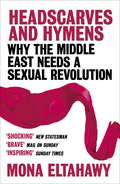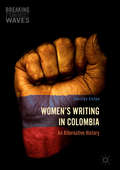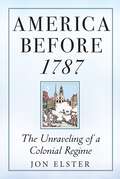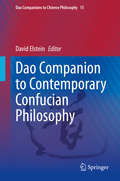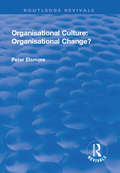- Table View
- List View
Urban Ghana and Privacy in the Digital Age: An Ethnographic Exploration (Materializing Culture)
by Elad Ben ElulThis book explores privacy practices and the role of digital technologies in the lives of urban Ghanaians, considering how they use language, materiality, and culture to maintain sharp boundaries between the private and public. Focusing on the harbour town of Tema, it offers rich ethnographic portraits that cover topics such as nightlife, domestic architecture, religion, and social media. The volume demonstrates how transformations across Africa such as Pentecostal reformation, neoliberal reforms, and rapid digitisation all raise the need for privacy among middle-class urbanites who use brand new (and very traditional) strategies to uphold an image of their economic or religious state. Overall the book highlights how digital technologies intertwine with local cultures and histories, and how digital anthropology enhances our understanding of the offline as much as the online. It makes a valuable contribution to discourse about the right for privacy and surveillance in the digital age, and will be of interest to scholars from anthropology and African studies.
The Anthropology of Peace and Reconciliation: Pax Humana (Critical Topics in Contemporary Anthropology)
by Nigel EltringhamThis book offers a uniquely comparative, case-study perspective on the anthropology of peace and reconciliation. In the contemporary world, the end of violent conflict often gives way to one, or a combination, of five interventions designed to strengthen “peace” and facilitate “reconciliation”. These interventions are: the reinvigoration of “traditional” conflict management mechanisms; the collection and preservation of testimony; truth commissions; international criminal trials; and memorialisation. Social anthropologists have challenged the received wisdom on which these interventions are based, arguing that they fail to adequately take into account and sensitively manage the needs and expectations of those who have lived through conflict. Exploring the five interventions through detailed ethnographic accounts from around the world, this book demonstrates that although social anthropologists adopt a critical stance, they do not dismiss “received wisdom” out of hand; rather, they advocate that interventions should be subject to continuous evaluation according to the evolving, often contradictory, needs and wishes of those who strive to survive among the ruins of their former lives. This is essential reading for scholars of peace studies, conflict resolution studies and those taking an anthropological approach to conflict, violence, human rights and law.
The Anthropology of Peace and Reconciliation: Pax Humana (Critical Topics in Contemporary Anthropology)
by Nigel EltringhamThis book offers a uniquely comparative, case-study perspective on the anthropology of peace and reconciliation. In the contemporary world, the end of violent conflict often gives way to one, or a combination, of five interventions designed to strengthen “peace” and facilitate “reconciliation”. These interventions are: the reinvigoration of “traditional” conflict management mechanisms; the collection and preservation of testimony; truth commissions; international criminal trials; and memorialisation. Social anthropologists have challenged the received wisdom on which these interventions are based, arguing that they fail to adequately take into account and sensitively manage the needs and expectations of those who have lived through conflict. Exploring the five interventions through detailed ethnographic accounts from around the world, this book demonstrates that although social anthropologists adopt a critical stance, they do not dismiss “received wisdom” out of hand; rather, they advocate that interventions should be subject to continuous evaluation according to the evolving, often contradictory, needs and wishes of those who strive to survive among the ruins of their former lives. This is essential reading for scholars of peace studies, conflict resolution studies and those taking an anthropological approach to conflict, violence, human rights and law.
Framing Africa: Portrayals of a Continent in Contemporary Mainstream Cinema
by Nigel EltringhamThe first decade of the 21st century has seen a proliferation of North American and European films that focus on African politics and society. While once the continent was the setting for narratives of heroic ascendancy over self (The African Queen, 1951; The Snows of Kilimanjaro, 1952), military odds (Zulu, 1964; Khartoum, 1966) and nature (Mogambo, 1953; Hatari!,1962; Born Free, 1966; The Last Safari, 1967), this new wave of films portrays a continent blighted by transnational corruption (The Constant Gardener, 2005), genocide (Hotel Rwanda, 2004; Shooting Dogs, 2006), ‘failed states’ (Black Hawk Down, 2001), illicit transnational commerce (Blood Diamond, 2006) and the unfulfilled promises of decolonization (The Last King of Scotland, 2006). Conversely, where once Apartheid South Africa was a brutal foil for the romance of East Africa (Cry Freedom, 1987; A Dry White Season, 1989), South Africa now serves as a redeemed contrast to the rest of the continent (Red Dust, 2004; Invictus, 2009). Writing from the perspective of long-term engagement with the contexts in which the films are set, anthropologists and historians reflect on these films and assess the contemporary place Africa holds in the North American and European cinematic imagination.
Women And Media In The Middle East: From Veiling To Blogging (PDF)
by Nahed EltantawyThe traditional image of the Middle Eastern woman, as portrayed by the Western media, has tended to be one of a woman oppressed by men and religion. Veiling intensifies this image of supposed powerlessness and imprisonment. However, the Arab Spring uprisings have introduced the West to women in the Middle East who do not conform to this stereotype, and have shown the Western media that Middle Eastern women cannot be categorized altogether as one oppressed, powerless group. This book investigates the diverse realities and complexities of women in the Middle East in terms of their relationship with media platforms old and new. Contributors offer a range of perspectives that discuss everything from media portrayals of the veil to women in film and television, from women's involvement as activists on the street to the role played in the Arab Spring by cyber activism. The collection provides insight into how some women in the Middle East are utilizing traditional as well as new media for purposes of self-expression, activism, and democratization, while also investigating media portrayals of women at home and in the West. This book was originally published as a special issue of Feminist Media Studies.
Women and Media in the Middle East: From Veiling to Blogging
by Nahed EltantawyThe traditional image of the Middle Eastern woman, as portrayed by the Western media, has tended to be one of a woman oppressed by men and religion. Veiling intensifies this image of supposed powerlessness and imprisonment. However, the Arab Spring uprisings have introduced the West to women in the Middle East who do not conform to this stereotype, and have shown the Western media that Middle Eastern women cannot be categorized altogether as one oppressed, powerless group.This book investigates the diverse realities and complexities of women in the Middle East in terms of their relationship with media platforms old and new. Contributors offer a range of perspectives that discuss everything from media portrayals of the veil to women in film and television, from women’s involvement as activists on the street to the role played in the Arab Spring by cyber activism. The collection provides insight into how some women in the Middle East are utilizing traditional as well as new media for purposes of self-expression, activism, and democratization, while also investigating media portrayals of women at home and in the West. This book was originally published as a special issue of Feminist Media Studies.
Women and Media in the Middle East: From Veiling to Blogging
by Nahed EltantawyThe traditional image of the Middle Eastern woman, as portrayed by the Western media, has tended to be one of a woman oppressed by men and religion. Veiling intensifies this image of supposed powerlessness and imprisonment. However, the Arab Spring uprisings have introduced the West to women in the Middle East who do not conform to this stereotype, and have shown the Western media that Middle Eastern women cannot be categorized altogether as one oppressed, powerless group.This book investigates the diverse realities and complexities of women in the Middle East in terms of their relationship with media platforms old and new. Contributors offer a range of perspectives that discuss everything from media portrayals of the veil to women in film and television, from women’s involvement as activists on the street to the role played in the Arab Spring by cyber activism. The collection provides insight into how some women in the Middle East are utilizing traditional as well as new media for purposes of self-expression, activism, and democratization, while also investigating media portrayals of women at home and in the West. This book was originally published as a special issue of Feminist Media Studies.
Headscarves and Hymens: Why the Middle East Needs a Sexual Revolution
by Mona Eltahawy'A ground-shaping book that defines the edge of so many vital contemporary debates. Hers is a voice simultaneously behind and beyond the veil' Colum McCannHeadscarves and Hymens explodes the myth that we should stand back and watch while women are disempowered and abused in the name of religion. In this laceratingly honest account, Eltahawy takes aim both at attitudes in the Middle East and at the western liberals who mistake misogyny for cultural difference. Her argument is clear: unless political revolution in the Arab world is accompanied by social and sexual revolution, no progress will be made.Headscarves and Hymens is the book the world has been crying out for: a powerful, fearless account of what it really means to be a woman in the Muslim world. 'A fascinating, can't-look-away, whistle-stop tour of the Middle East' Daily Telegraph'Brave and impassioned . . . A shocking book, and one that will make anyone who has seen veiling as a cultural issue think very hard about what is really going on' Mail on Sunday
Women's Writing in Colombia: An Alternative History (Breaking Feminist Waves)
by Cherilyn ElstonWinner of the Montserrat Ordóñez Prize 2018This book provides an original and exciting analysis of Colombian women’s writing and its relationship to feminist history from the 1970s to the present. In a period in which questions surrounding women and gender are often sidelined in the academic arena, it argues that feminism has been an important and intrinsic part of contemporary Colombian history. Focusing on understudied literary and non-literary texts written by Colombian women, it traces the particularities of Colombian feminism, showing how it has been closely entwined with left-wing politics and the country’s history of violence. This book therefore rethinks the place of feminism in Latin American history and its relationship to feminisms elsewhere, challenging many of the predominant critical paradigms used to understand Latin American literature and culture.
Digital Literature and Critical Theory (Routledge Interdisciplinary Perspectives on Literature)
by Annika ElstermannThe aim at the core of this book is a synthesis of increasingly popular and culturally significant forms of digital literature on the one hand, and established literary and critical theory on the other: reading digital texts through the lens of canonical theory, but also reading this more traditional theory through the lens of digital texts and related media. In a field which has often regarded the digital as apart from traditional literature and theory, this book highlights continuities in order to analyse digital literature as part of a longer literary tradition. Using examples from social media to video games and works particularly by postmodern and poststructuralist theorists, Digital Literature and Critical Theory contextualises digital forms among their analogue precursors and traces ongoing social developments which find expression in these cultural phenomena, including power dynamics between authors and readers, the individual in (post-)modernity, consumerism, and the potential for intersubjective exchange.
Digital Literature and Critical Theory (Routledge Interdisciplinary Perspectives on Literature)
by Annika ElstermannThe aim at the core of this book is a synthesis of increasingly popular and culturally significant forms of digital literature on the one hand, and established literary and critical theory on the other: reading digital texts through the lens of canonical theory, but also reading this more traditional theory through the lens of digital texts and related media. In a field which has often regarded the digital as apart from traditional literature and theory, this book highlights continuities in order to analyse digital literature as part of a longer literary tradition. Using examples from social media to video games and works particularly by postmodern and poststructuralist theorists, Digital Literature and Critical Theory contextualises digital forms among their analogue precursors and traces ongoing social developments which find expression in these cultural phenomena, including power dynamics between authors and readers, the individual in (post-)modernity, consumerism, and the potential for intersubjective exchange.
America before 1787: The Unraveling of a Colonial Regime
by Jon ElsterAn original account, drawing on both history and social science, of the causes and consequences of the American RevolutionWith America before 1787, Jon Elster offers the second volume of a projected trilogy that examines the emergence of constitutional politics in France and America. Here, he explores the increasingly uneasy relations between Britain and its American colonies and the social movements through which the thirteen colonies overcame their seemingly deep internal antagonisms.Elster documents the importance of the radical uncertainty about their opponents that characterized both British and American elites and reveals the often neglected force of enthusiasm, and of emotions more generally, in shaping beliefs and in motivating actions. He provides the first detailed examinations of &“divide and rule&” as a strategy used on both sides of the Atlantic and of the rise and fall of collective action movements among the Americans. Elster also explains how the gradual undermining in America of the British imperial system took its toll on transatlantic relations and describes how state governments and the American Confederation made crucial institutional decisions that informed and constrained the making of the Constitution.Drawing on a wide range of historical sources and on theories of modern social science, Elster brings together two fields of scholarship in innovative and original ways. The result is a unique synthesis that yields new insights into some of the most important events in modern history.
Explaining Social Behavior: More Nuts And Bolts For The Social Sciences
by Jon ElsterIn this new edition of his critically acclaimed book, Jon Elster examines the nature of social behavior, proposing choice as the central concept of the social sciences. Extensively revised throughout, the book offers an overview of key explanatory mechanisms, drawing on many case studies and experiments to explore the nature of explanation in the social sciences; an analysis of the mental states - beliefs, desires, and emotions - that are precursors to action; a systematic comparison of rational-choice models of behavior with alternative accounts, and a review of mechanisms of social interaction ranging from strategic behavior to collective decision making. A wholly new chapter includes an exploration of classical moralists and Proust in charting mental mechanisms operating 'behind the back' of the agent, and a new conclusion points to the pitfalls and fallacies in current ways of doing social science, proposing guidelines for more modest and more robust procedures.
France before 1789: The Unraveling of an Absolutist Regime
by Jon ElsterA masterful new account of old regime France by one of the world's most prominent political philosophersFrance before 1789 traces the historical origins of France's National Constituent Assembly of 1789, providing a vivid portrait of the ancien régime and its complex social system in the decades before the French Revolution. Jon Elster writes in the spirit of Alexis de Tocqueville, who described this tumultuous era with an eye toward individual and group psychology and the functioning of institutions. Whereas Tocqueville saw the old regime as a breeding ground for revolution, Elster, more specifically, identifies the rural and urban conflicts that fueled the constitution-making process from 1789 to 1791. He presents a new approach to history writing, one that supplements the historian's craft with the tools and insights of modern social science. Elster draws on important French and Anglo-American scholarship as well as a treasure trove of historical evidence from the period, such as the Memoirs of Saint-Simon, the letters of Madame de Sévigné, the journals of the lawyer Barbier and the bookseller Hardy, the Remonstrances of Malesherbes, and La Bruyère's maxims.Masterfully written and unparalleled in scope, France before 1789 is the first volume of a trilogy that promises to transform our understanding of constitution making in the eighteenth century. Volume 2 will look at revolutionary America in the years leading up to the Constitutional Convention of 1787 while the third volume will examine all facets of the French and American assemblies, from how they elected their delegates and organized their proceedings to how they addressed issues of separation of powers and representation.
France before 1789: The Unraveling of an Absolutist Regime
by Jon ElsterA masterful new account of old regime France by one of the world's most prominent political philosophersFrance before 1789 traces the historical origins of France's National Constituent Assembly of 1789, providing a vivid portrait of the ancien régime and its complex social system in the decades before the French Revolution. Jon Elster writes in the spirit of Alexis de Tocqueville, who described this tumultuous era with an eye toward individual and group psychology and the functioning of institutions. Whereas Tocqueville saw the old regime as a breeding ground for revolution, Elster, more specifically, identifies the rural and urban conflicts that fueled the constitution-making process from 1789 to 1791. He presents a new approach to history writing, one that supplements the historian's craft with the tools and insights of modern social science. Elster draws on important French and Anglo-American scholarship as well as a treasure trove of historical evidence from the period, such as the Memoirs of Saint-Simon, the letters of Madame de Sévigné, the journals of the lawyer Barbier and the bookseller Hardy, the Remonstrances of Malesherbes, and La Bruyère's maxims.Masterfully written and unparalleled in scope, France before 1789 is the first volume of a trilogy that promises to transform our understanding of constitution making in the eighteenth century. Volume 2 will look at revolutionary America in the years leading up to the Constitutional Convention of 1787 while the third volume will examine all facets of the French and American assemblies, from how they elected their delegates and organized their proceedings to how they addressed issues of separation of powers and representation.
Dao Companion to Contemporary Confucian Philosophy (Dao Companions to Chinese Philosophy #15)
by David ElsteinThis edited volume presents a comprehensive examination of contemporary Confucian philosophy from its roots in the late 19th century to the present day. It provides a thorough introduction to the major philosophers and topics in contemporary Confucian philosophy. The individual chapters study the central figures in 20th century Confucian philosophy in China, Taiwan, and Hong Kong, as well as the important influences on recent Confucian philosophy. In addition, topical chapters focus on contemporary Confucian theory of knowledge, ethics, politics, aesthetics, and views of human nature. The volume brings together scholars from around the world to provide a sound overview of the philosophy of the period and illustrate the important current debates. Confucian philosophy has been undergoing a revival in China for more than three decades, and this book presents the most significant work of the past century and more. By giving a detailed account of the philosophical positions involved, explaining the terminology of contemporary Confucian philosophy, and situating the views in their historical context, this volume enables the reader to understand what is at stake and evaluate the arguments.
Women at War
by Elspeth Cameron Ritchie and Anne L. NaclerioIn the very first text of its kind, Women at War brings together all available information and experience on women's physical and mental health in one resource to enlighten the practitioners caring for them. Our U.S Department of Defense is approximately 15% women with over 300,000 women having deployed since September 11th, 2001. This book reviews the epidemiology, changes in policy and demographics of women in the services, the factors affecting their health and health care while serving in austere environments, issues related to reproductive and urogenital health and how health care providers can help prepare and prevent illness. The book also looks at mental health issues to include PTSD and other psychological effects of war, intimate partner violence, sexual assault and suicide, as well as the veteran experience. The book brings together researchers, clinicians, and service member experience and presents the information in a practical, actionable format. It also highlights areas where data is lacking and more study is demanded.
The End of the Peasantry in Southeast Asia: A Social and Economic History of Peasant Livelihood, 1800-1990s (A Modern Economic History of Southeast Asia)
by R.E. ElsonThis book analyses the changing context and conditions of production and livelihood amongst Southeast Asia's peasants since the beginning of the nineteenth century. It argues that with demographic growth and the nineteenth century development of great global markets based on small-scale production, the size and economic significance of peasantries throughout the region was magnified. However, such changes brought with them new forces - stronger states, more regular legal systems, a revolution in communications, intensive commercialisation - which themselves worked to undermine the foundations of peasant society and, eventually, to transform peasants into farmers, workers and citizens.
Strukturwandel und Wirtschaftspolitik in der Region: Eine Untersuchung der Region Ostwestfalen-Lippe (Forschungsberichte des Landes Nordrhein-Westfalen #3231)
by Wolfram Elsner Siegfried KatterleArk of Civilization: Refugee Scholars and Oxford University, 1930-1945
by Jaś Elsner Sally Crawford Katharina UlmschneiderIn the opening decades of the twentieth century, Germany was at the cutting edge of arts and humanities scholarship across Europe. However, when many of its key thinkers - leaders in their fields in classics, philosophy, archaeology, art history, and oriental studies - were forced to flee to England following the rise of the Nazi regime, Germany's loss became Oxford's gain. From the mid-1930s onwards, Oxford could accurately be described as an 'ark of knowledge' of western civilization: a place where ideas about art, culture, and history could be rescued, developed, and disseminated freely. The city's history as a place of refuge for scientists who were victims of Nazi oppression is by now familiar, but the story of its role as a sanctuary for cultural heritage, though no less important, has received much less attention. In this volume, the impact of Oxford as a shelter, a meeting point, and a centre of thought in the arts and humanities specifically is addressed, by looking both at those who sought refuge there and stayed, and those whose lives intersected with Oxford at crucial moments before and during the war. Although not every great refugee can be discussed in detail in this volume, this study offers an introduction to the unique conjunction of place, people, and time that shaped Western intellectual history, exploring how the meeting of minds enabled by libraries, publishing houses, and the University allowed Oxford's refugee scholars to have a profound and lasting impact on the development of British culture. Drawing on oral histories, previously unpublished letters, and archives, it illuminates and interweaves both personal and global histories to demonstrate how, for a short period during the war, Oxford brought together some of the greatest minds of the age to become the custodians of a great European civilization.
Figurines: Figuration and The Sense of Scale (Visual Conversations in Art and Archaeology Series)
by Jaś ElsnerFigurines are objects of handling. As touchable objects, they engage the viewer in different ways from flat art, whether relief sculpture or painting. Unlike the voyeuristic relationship of viewing a neatly framed pictorial narrative as if from the outside, the viewer as handler is always potentially and without protection within the narrative of figurines. As such, they have potential for a potent, even animated, agency in relation to those who use them. This volume concerns figurines as archaeologically-attested materials from literate cultures with surviving documents that have no direct links of contiguity, appropriation, or influence in relation to each other. It is an attempt to put the category of the figurine on the table as a key conceptual and material problematic in the art history of antiquity. It does so through comparative juxtaposition of close-focused chapters drawn from deep art-historical engagement with specific ancient cultures - Chinese, pre-Columbian Mesoamerican, and Greco-Roman. It encourages comparative conversation across the disciplines that constitute the art history of the ancient world through finding categories and models of discourse that may offer fertile ground for comparison and antithesis. It extends the rich and astute literature on prehistoric figurines into understanding the figurine in historical contexts, where literary texts and documents, inscriptions, or surviving terminologies can be adduced alongside material culture. At stake are issues of figuration and anthropomorphism, miniaturization and portability, one-off production and replication, and substitution and scale at the interface of archaeology and art history.
Organisational Culture: Organisational Change? (Routledge Revivals)
by Peter ElsmoreThis title was first published in 2001. When organizational change occurs, members of the organization can feel insecure in the face of a seemingly uncertain future. This work investigates the links between organizational culture and organizational change by looking at two businesses that have been privatized - British Gas and British Telecom - and the processes surrounding the ways these organizations changed in the mid 1990s. It includes interviews with middle-ranking and senior officals, illustrating that anguish is experienced not only by those on the lower rungs of the corporate ladder.
Organisational Culture: Organisational Change? (Routledge Revivals)
by Peter ElsmoreThis title was first published in 2001. When organizational change occurs, members of the organization can feel insecure in the face of a seemingly uncertain future. This work investigates the links between organizational culture and organizational change by looking at two businesses that have been privatized - British Gas and British Telecom - and the processes surrounding the ways these organizations changed in the mid 1990s. It includes interviews with middle-ranking and senior officals, illustrating that anguish is experienced not only by those on the lower rungs of the corporate ladder.







